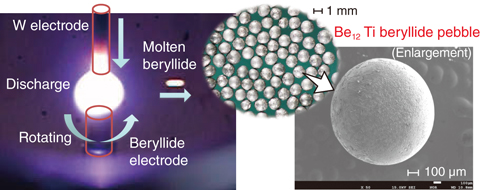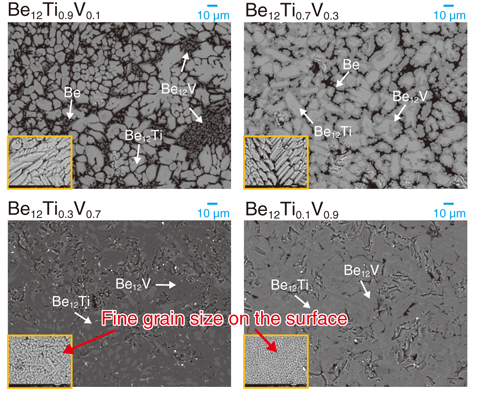
Fig.9-24 Establishment of a granulation process for beryllide pebbles using a rotating-electrode method

Fig.9-25 Successful granulation of ternary beryllide pebbles

Fig.9-26 Comparison of properties
Tritium as a fuel for a fusion reactor is produced by reacting neutrons generated from a fusion reaction with lithium (Li) as a breeder. At this time, to produce tritium with high efficiency, a neutron-multiplier material (so called because it multiplies the neutron number) is indispensably needed. Research and development of beryllium (Be) intermetallic compounds (beryllides) as candidate multiplier materials, which are more stable for high-temperature applications, have been carried out within the framework of broader approach (BA) activities because critical issues, such as the production of hydrogen gas generated by a reaction between Be and water vapor accidently leaked from the coolant, are anticipated.
Owing to the highly oxidant nature of Be, most beryllides fabricated by commercial powder metallurgy have been brittle and difficult to machine. However, using an optimized plasma-sintering method consisting of plasma activation by a pulse current and sintering by a direct current, a rod-shaped beryllide with good machinability and high thermal-shock resistance has been successfully fabricated as a granulation-starting material. Furthermore, beryllide pebbles 1 mm in diameter have been successfully fabricated using the rod material, and a fundamental technique for the granulation of beryllide has been established (Fig.9-24). Since beryllides have higher melting points and are more stable than Be, some results have shown them to have considerable potential as neutron-multiplying materials.
However, one issue has arisen, namely, that additional homogenization treatment is necessary owing to variation in the phase composition and existence of the Be phase after the granulation, although beryllide pebbles with a chemical composition of Be12Ti were fabricated at the first step. After consideration of the optimized chemical composition with no phase variation, single-phase Be12V pebbles were successfully fabricated by direct granulation.
Since the neutron multipliers with large amounts are loaded in the blanket, pebbles with high strength are required; however, the Be12V pebble indicated a relatively low collapse strength. To solve this issue, extensive research and development of ternary Be-Ti-V beryllide pebbles has been commenced and ternary pebbles with strengths higher than those of Be12V pebbles have been successfully fabricated. It was obvious from experiments that in cases of chemical composition with Be12Ti0.3V0.7 and Be12Ti0.1V0.9, ternary beryllide pebbles with very fine grains (Fig.9-25), which consisted of dual phases (Be12Ti and Be12V) without a Be phase corresponding to no homogenization treatment, were successfully fabricated while the Be phase undesirably increased with an increase in titanium (Ti) amount in the ternary system. Moreover, results of hydrogen generation and collapse strength suggested that the ternary beryllide pebbles indicated relatively low hydrogen generation (Fig.9-26(a)) and higher strength (Fig.9-26(b)) than Be12V pebbles. Accordingly, we have successfully fabricated the world’ first ternary pebbles with excellent properties.
<Previous: 9-8 | Next: 10 Computational Science and E-Systems Research>